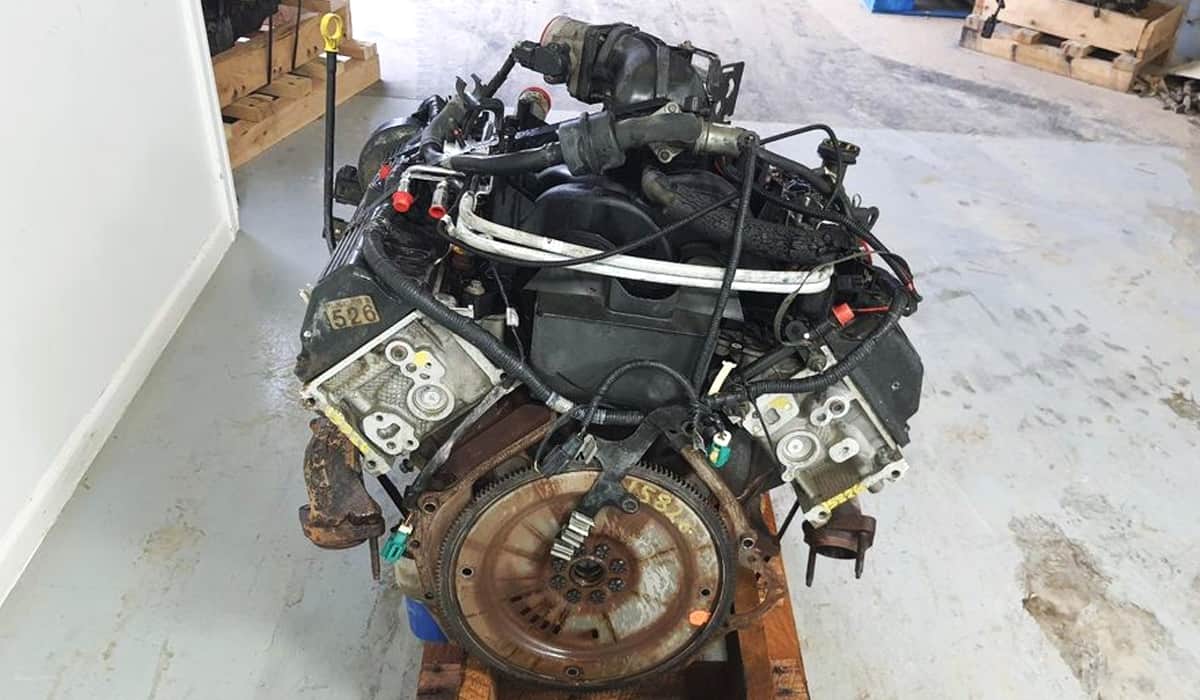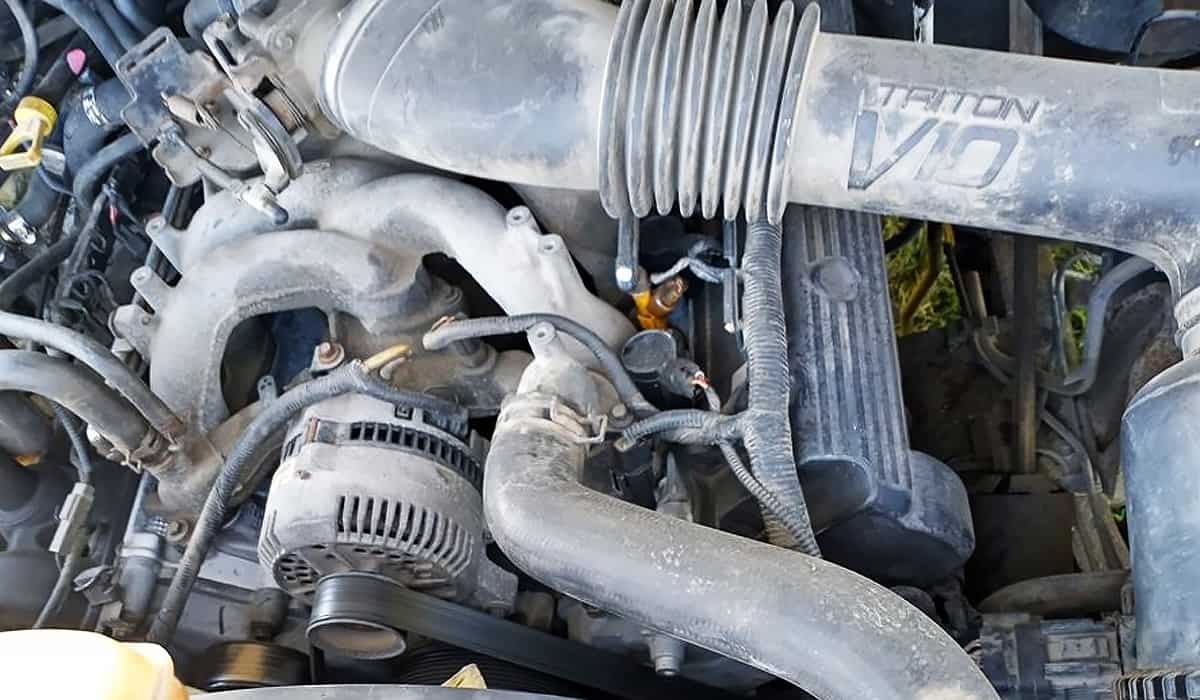Ford V10 Reliability: Which Models Should You Avoid?
The Ford Triton V10 has been around for two decades and has a reputation for being durable and reliable. While there are some reliable models available in the market, you’ll need to avoid the problematic versions of the Ford V10.
The Ford Triton V10 models that should be avoided are those from 1995-2003 and the 2017 model. The main problems with its engine were the bad spark plugs, the exhaust leaks, the fluid leaks, and the poor fuel economy, to name a few. However, some versions of the Ford V10 are quite reliable.
Let’s explore the problematic versions of the Ford V10, their main problems, and which models are reliable.
Which Ford V10 Model Years Should Be Avoided?

The Triton V10s were powerful engines being the go-to for many car enthusiasts. However, some models weren’t that reliable and didn’t deliver the required power. The V10 engines weren’t completely useless and have had some good and bad years.
Ford V10 models to avoid include:
Models Released Before 2000
The Ford Triton V10 was notorious for its one design flaw—the spark plug. A spark plug ignites the combustion to start a vehicle. In the V10, the spark plug had a habit of ejecting, which would immediately kill power to the engine. You can imagine how frustrating that is.
At times, because the engine would heat up at such a high temperature, the spark plug would start melting. So, if you’re buying a used Ford V10, avoid all models released before 2000.
The 2000 Ford V10 Model
Models before 2000 were bad, but the problems became worse in the 2000 model Ford V10. Buyers complained about the terrible fuel economy. The engine has 10 cylinders and requires premium fuel, which can burn a hole in your wallet!
Another problem with this model is the exhaust bolts end up breaking and need to be replaced often.
The 2001 Ford V10 Model
The 2001 model was slightly better than its predecessor but still quite problematic. There have been consumer reports complaining about the mileage and that the engine is very expensive to repair whenever any problem arises.
This model also has gear-shifting problems, and it’s difficult to switch gears, especially when driving uphill.
The Ford V10 2003 Model
The V10 models after 2002 were updated with 3 valves per cylinder and had higher performance. The older V10 models, in comparison, had less power and torque.
The Positive Crankcase (PCV) valve hose in the V10 models was connected from the engine to the intake system. However, in the 2003 model, the PCV hose would start cracking or breaking over time, which caused leaks.
Another problem with the V10 mVentilation models manufactured after 2002 had to do with the exhaust manifold. The manifold was held in place under the engine by small bolts, which would often rot and break.
Drivers also complained about exhaust leaks which would end up in the passenger compartment.
The 2017 Ford V10 Model
After 2003, many problems with the Ford V10 engine were fixed, and the vehicle was becoming reliable again. However, this changed with the release of the 2017 model. Drivers also reported misfires on the cylinders, caused by a compression loss.
With the newer models, another problem that arises is the shifting gears due to the computer connections. The automatic transmission sometimes has trouble shifting if the vacuum seal is broken or the connections weren’t tightened properly.
While this isn’t the worst of problems, it’s still a good reason to avoid this model.
Which Ford V10 Model Years Had Spark Plug Problems?
Most Ford V10 models released from 1995-2002 had spark plug problems. The spark plug would shoot out of the cylinder and would often break while being taken out of the cylinder. The two-piece spark plug design made this problem worse, and the spark plug would simply fall apart.
This was a recurring issue with all models released until 2002, when Ford managed to resolve the issue. While it’s not something that can’t easily be fixed, you can’t use a different spark plug type in this engine, and finding parts for these models can be difficult.
What are Common Problems with the V10 6.8 L?

While the Triton V10 6.8 L has some issues, most can be covered by an experienced mechanic. Without these issues, the Ford V-10 engine is reliable and can last for around 300, 000 miles with the right care and maintenance.
However, some of these problems with these vehicles are recurring, which increases the vehicle’s maintenance costs.
Common problems with the V10 6.8 L include:
Spark Plug Issues
The most common issue with the V10 was the spark plugs would get stuck in cylinders or would break apart when you would try to remove them. The plugs would also sometimes blow out and cause damage to other components.
Ford had to introduce a warranty to fix this problem, but even this didn’t cover the spark plugs or repair costs. But Ford fixed the problem after 2008 in its newer V10 models.
PVC Hose Cracks
A recurring issue with the V10 engine was the PVC hose which kept cracking and occasionally breaking as well. The crack would lead to a rough idle, which was not a pleasant experience and resulted in combustion issues.
Head Gasket Failure
Head gasket failure is when the engine burns an excessive amount of oil and releases a foul smell. A leaky coolant passage usually causes this. There have been complaints of head gasket failure in the V10 engine caused by an oil and coolant leakage.
The combustion gasses pressurize the coolant passages, reducing the coolant levels and affecting the engine’s functioning.
Poor Gas Mileage
Another issue with the V10 is its poor fuel economy due to the large engine design. The V10 offers between 7 and 10 MPG, which does not hold up in today’s competitive market with cheaper and better options out there.
After hitting 100, 000 miles, the gas mileage becomes worse because of multiple issues. Buyers usually end up adding third-party tuning chips to improve fuel economy. However, this is an additional cost, and you’re much better off getting a vehicle with better gas mileage.
Exhaust Leaks
The Ford V10 is also notorious for its exhaust leaks. The problem lies with bolts and threads, which would loosen up and create an exhaust leak.
The exhaust leaks affect the performance of the engine. There would be loud noises coming from the exhaust, a lot of acceleration, and there would be a certain exhaust smell.
Another issue that would occur because of the loose exhaust bolts was that they would become rusty and wouldn’t properly be able to keep the exhaust in place. The leaks lead to a loss in the back pressure, which causes performance issues for the engine.
Burning Oil
The V10 burns around a quart of oil every 1000 miles. However, if there are worn-down parts in the engine, the engine may start burning more. Similarly, if the engine hasn’t been in use for a while, the synthetic oils might have evaporated, causing more oil loss.
This is why you’ll need to service the engine sooner than you would with other 4×4 vehicles.
No On-Board Diagnostics
Some versions of the Triton V10 didn’t have onboard diagnostics, which made it difficult for drivers to identify the problem areas in the engine.
This means you’ll have to visit the mechanic, even for smaller issues, which increases the maintenance of the vehicle.
Are Ford V10 Engines Good?

Ford V10 engines are powerful and have excellent towing capacity compared to other engines in the market. These engines were reliable and durable, which is why there are still drivers out there who are interested in the V10 engines.
The V10 also had a high RPM range, which means it ran the light in lower gears and reduced the amount of wear on the engine. If you take care of some of the issues immediately, like the spark plug problem, you’ll have a powerful engine that can still hold its own.
The V10 was a part of both the commercial and recreational Ford trucks and was once known as the best of Ford’s Modular engine family.
It’s still recommended for towing and trucking or for motorhomes and can be less expensive than diesel for such activities.
Is it Worth Getting a Ford V10 Engine?
As with most used engines, a Ford V10 engine from the early 2000s or later can be used but needs to be checked out by a mechanic to make sure all components of the engine are functioning properly.
The Ford Triton V10 was used a lot in the F-250 and the F-350 Super Duties trucks series but was discontinued. The engine is now only utilized for specific vehicles such as big motorhomes and buses.
They are no longer a viable option for those who want to opt for an efficient SUV engine in this price range. While you can still get decent power from these engines, they aren’t fuel-efficient or economically viable.
What Year Did Ford V10 Go to 3 Valve?
Ford transferred to a three-valve upgrade in 2005. Initially, Ford released the engine with two valves per cylinder, but there were several problems with the engine that they needed to fix. The three-valve engine was much more powerful and durable.
The maximum power increased to 365 horsepower and 460 lb-ft of torque from the previous engine’s 275 horsepower. In the three-valve engine, Ford also modified the spark plug and added more threads to avoid the previous spark plug problems.
However, some complained that the spark plugs would just break now instead and that the problem wasn’t properly dealt with.
What Year Did Ford Discontinue the V10?
Ford stopped making the V10 in 2011 for their trucks and SUVs. They stopped production of the 6.8L V10 completely in 2019. You probably won’t come across a V10 on a Ford passenger car or the F150 series.
A new two-valve 6.2-liter V-8 gasser replaced the V10.
The V10 was just not as popular as other diesel engines. While the V10 is cheaper than many diesel engines, it uses up so much fuel it becomes expensive to run daily. Ford replaced the V10 engine with a faster, more economical, and more compact V8 engine.
However, if you’re in the market for a Ford V10 specifically, you’ll find it without a lot of trouble. Ford released over 750,000 vehicles with this motor, and you could get a bargain on used ones.
What is the Ford Triton V10s Life Expectancy?
The Ford Triton V10 engine usually lasts for at least 250,000-300,000 miles before any repairs are required. A lot of drivers have reported that their V10 engine has lasted for much longer, some even going over 400,000 miles.
That’s a staggering number, even for diesel engines, and you could easily drive this engine for a couple of decades with occasional repairs.
To increase the longevity of your engine, you should do regular maintenance, especially considering that it burns a lot of oil and needs to be serviced more frequently.
